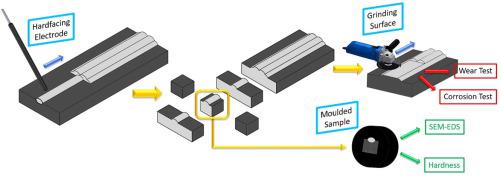当前位置:
X-MOL 学术
›
Eng. Sci. Technol. Int. J.
›
论文详情
Our official English website, www.x-mol.net, welcomes your
feedback! (Note: you will need to create a separate account there.)
The influence of chromium content on wear and corrosion behavior of surface alloyed steel with Fe(16−x)Crx(B,C)4 electrode
Engineering Science and Technology, an International Journal ( IF 5.1 ) Pub Date : 2020-08-01 , DOI: 10.1016/j.jestch.2020.08.003 Engin Kocaman , Bülent Kılınç , Mustafa Durmaz , Şaduman Şen , Uğur Şen
Engineering Science and Technology, an International Journal ( IF 5.1 ) Pub Date : 2020-08-01 , DOI: 10.1016/j.jestch.2020.08.003 Engin Kocaman , Bülent Kılınç , Mustafa Durmaz , Şaduman Şen , Uğur Şen

|
Abstract In this study, the electrodes containing Fe(16−X)CrX(B,C)4 (X = 3,4,5) were used for surface alloying on an AISI 1010 steel substrate. The alloy structure of the coating exhibits in-situ composite structure with a large amount of reinforcing carbides and borides phases as to be hypoeutectic and hypereutectic structure in the surface alloyed layer. The obtained composition of the alloy shows that it contains much more interstitial hard phases in the alloyed layer than the conventional hardfacing alloys used in the industrial applications for the hardfacing of the steels. The morphological and microstructural properties showed that layer microstructure changed from hypoeutectic to hypereutectic structure with an increase in chromium content. The results of these studies revealed that the microstructure of hardfacing layers consists of interstitial phases of α(Fe-Cr) and (Fe,Cr)23(C,B)6 as major phases, (Fe,Cr)2(C,B) and (Fe,Cr)7(C,B)3 as minor phases in the in-situ composite structure. The composite hardness’ in the alloyed surface layers of the Fe(16−X)CrX(B,C)4 alloys ranged from 711 HV to 1164.3 HV. Wear test against alumina ball shows that the friction coefficients of the surface alloyed layers decreased with increase in applied loads and decrease in chromium content in the Fe(16−X)CrX(B,C)4 alloy composition. Coefficient of friction ranged from 0.55 to 0.79 in the present study. Wear rates of the surface alloyed steels caused to increase with decrease in chromium content and increase in applied loads. The wear rates of the alloyed layer changed between 3.07 × 10 and 5 mm3/m and 6.95 × 10−5 mm3/m. The corrosion resistance of the alloyed layers was measured by a potentiostatic polarization test. Icorr and Ecorr of the coated layers changed from 1.813 to 9.965 µA/cm2 and −704.786 to −745.792 mV, depending on alloyed layer compositions. With increasing chromium content, the corrosion resistance of the coating layer has changed in a nobler side.
中文翻译:

铬含量对Fe(16-x)Crx(B,C)4电极表面合金钢磨损腐蚀行为的影响
摘要 在本研究中,使用含有 Fe(16-X)CrX(B,C)4 (X = 3,4,5) 的电极在 AISI 1010 钢基材上进行表面合金化。涂层合金组织呈原位复合结构,含有大量强化碳化物和硼化物相,在表面合金层呈亚共晶和过共晶结构。所获得的合金组成表明,与工业应用中用于钢的表面硬化的常规表面硬化合金相比,它在合金层中包含更多的间隙硬质相。形貌和显微组织特性表明,随着铬含量的增加,层状组织由亚共晶组织转变为过共晶组织。这些研究的结果表明,堆焊层的微观结构由间隙相 α(Fe-Cr) 和 (Fe,Cr)23(C,B)6 作为主要相,(Fe,Cr)2(C,B) ) 和 (Fe,Cr)7(C,B)3 作为原位复合结构中的次要相。Fe(16-X)CrX(B,C)4 合金合金化表面层的复合硬度范围为 711 HV 至 1164.3 HV。对氧化铝球的磨损试验表明,表面合金层的摩擦系数随着施加载荷的增加和 Fe(16-X)CrX(B,C)4 合金成分中铬含量的降低而降低。在本研究中,摩擦系数从 0.55 到 0.79 不等。表面合金钢的磨损率随着铬含量的降低和施加载荷的增加而增加。合金层的磨损率在 3 之间变化。07 × 10 和 5 mm3/m 和 6.95 × 10−5 mm3/m。通过恒电位极化试验测量合金层的耐腐蚀性。涂层的 Icorr 和 Ecorr 从 1.813 到 9.965 µA/cm2 和 -704.786 到 -745.792 mV,这取决于合金层的成分。随着铬含量的增加,镀层的耐蚀性发生了更高的变化。
更新日期:2020-08-01
中文翻译:

铬含量对Fe(16-x)Crx(B,C)4电极表面合金钢磨损腐蚀行为的影响
摘要 在本研究中,使用含有 Fe(16-X)CrX(B,C)4 (X = 3,4,5) 的电极在 AISI 1010 钢基材上进行表面合金化。涂层合金组织呈原位复合结构,含有大量强化碳化物和硼化物相,在表面合金层呈亚共晶和过共晶结构。所获得的合金组成表明,与工业应用中用于钢的表面硬化的常规表面硬化合金相比,它在合金层中包含更多的间隙硬质相。形貌和显微组织特性表明,随着铬含量的增加,层状组织由亚共晶组织转变为过共晶组织。这些研究的结果表明,堆焊层的微观结构由间隙相 α(Fe-Cr) 和 (Fe,Cr)23(C,B)6 作为主要相,(Fe,Cr)2(C,B) ) 和 (Fe,Cr)7(C,B)3 作为原位复合结构中的次要相。Fe(16-X)CrX(B,C)4 合金合金化表面层的复合硬度范围为 711 HV 至 1164.3 HV。对氧化铝球的磨损试验表明,表面合金层的摩擦系数随着施加载荷的增加和 Fe(16-X)CrX(B,C)4 合金成分中铬含量的降低而降低。在本研究中,摩擦系数从 0.55 到 0.79 不等。表面合金钢的磨损率随着铬含量的降低和施加载荷的增加而增加。合金层的磨损率在 3 之间变化。07 × 10 和 5 mm3/m 和 6.95 × 10−5 mm3/m。通过恒电位极化试验测量合金层的耐腐蚀性。涂层的 Icorr 和 Ecorr 从 1.813 到 9.965 µA/cm2 和 -704.786 到 -745.792 mV,这取决于合金层的成分。随着铬含量的增加,镀层的耐蚀性发生了更高的变化。











































 京公网安备 11010802027423号
京公网安备 11010802027423号